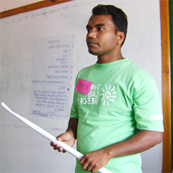|
|
|
Nepal
Effect of Youth Leadership and Peacebuilding Training: Change at Cultural Level
Source: Project Evaluation Report, 'Youth Engagement in Nepal's Democratization Process', Project implemented by SFCG in partnership with All People's Development Centre, Lahan. Evaluation Report submitted by Tulasi R. Nepal, March, 2010. p.11
Theory of Change: If community people work together for their common needs, that will reduce prevailing prejudice/stereotype based on various dividing lines, e.g. caste, origin, generation to each other.
Case
There was a prolonged conflict in Bhatoulia VDC over the route used by Hindus for a Dashain procession, where they dispose a clay Statue of the Goddess Durga in the nearby river. This tradition has been ongoing for decades. However, the Muslim members of the village were unhappy that the procession passed though their section, and felt intimidated by the Hindus. They argued that despite having another route, which covers more Hindu households, the Hindus carry out the procession through the Muslim village to intimidate them. Every year, these two communities fought over the issue, often resulting in casualties.

Akbar (in the picture)and Saroj, recent trainees of Youth Leadership and Peacebuilding program, wanted to use the tools of dispute resolution and conflict analysis they had learnt about to resolve this prolonged conflict. They belonged to each section of the community, so they decided to talk to the leaders in their respective community. They inspected the route used in the procession and realized that Hindus could bypass the Muslim community by using an alternative route, and also cover more Hindu households. They said:
"We realized that the root cause of the conflict was more of an ego issue between the leaders of the two communities rather than a genuine conflict. We prepared maps of both the existing route and the alternative to explain the problems of the old route and benefits on the new one."
"In the meantime we realized that the local youth club has only Hindu members in it. We started encouraging Muslim youth to participate in club activities. With their participation, we were able to access leaders from both communities and talk to them about the benefits and challenges of both options. Then we organized a larger meeting with representatives of both communities. In the end, the Hindu members said the tradition is not important, it the communal harmony and cooperation that matters most."
The Hindu community agreed to change their route. Muslim youth from the club worked as volunteers during the Durga festival7. The year 2009 did not face any conflict during the procession.
Comments
The communities were involved in a violent conflict due to a lack of empathy for each other. The initiatives taken by the youth club identified the cause of their conflict and a solution. If communities work together for their common needs, that will reduce prevailing prejudice/stereotype based on various dividing lines.
This example can be replicated to resolve any other issues of conflict. That way, we can expect the long-term peace in the community.
|